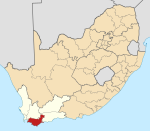Theewaterskloof Local Municipality
Theewaterskloof | |
|---|---|
|
UTC+2 (SAST ) | |
| Municipal code | WC031 |
Theewaterskloof Municipality (
Geography
The municipality covers an area of 3,232 square kilometres (1,248 sq mi) in the western interior of the
The western area of the municipality is the
According to the
The largest town in the municipality is
History
At the end of the
While the negotiations to end apartheid were taking place a process was established for local authorities to negotiate voluntary mergers. Such mergers took place in two towns in the Theewaterskloof region: in August 1993 the Municipality of Riviersonderend merged with the Riviersonderend Management Committee to form the Municipality for the Area of Riviersonderend, and in January 1994 the Municipality of Caledon merged with the Bergsig Management Committee to form the Municipality for the Area of Caledon.
After the
- In October 1994:
- the Municipality of Grabouw and the Pineview Management Committee were replaced by the Grabouw TLC.
- the Villiersdorp Municipality and the Villiersdorp Management Committee were replaced by the Villiersdorp TLC.
- In November 1994 the Botrivier Local Council was replaced by the Botrivier TLC.
- In December 1994 the Municipality for the Area of Riviersonderend was replaced by the Riviersonderend TLC.
- In January 1995:
- the Municipality for the Area of Caledon was replaced by the Caledon TLC.
- the Municipality of Greyton and the Heuwelkruin Management Committee were replaced by the Greyton TLC.
- the Genadendal Management Board was replaced by the Genadendal TLC.
- In February 1995 the Myddleton Management Committee was replaced by the Myddleton TLC.
These transitional councils were initially made up of members nominated during the negotiations, some of whom had been councillors of the previous local authorities, while others represented political parties and community organisations. In May 1996 elections were held to replace the nominated councils with elected councils. At these elections the Overberg District Council was established, replacing the Overberg Regional Services Council. Transitional representative councils (TRCs) were also elected to represent rural areas outside the TLCs on the District Council; the area that was to become Theewaterskloof included parts of the Nuweberg, Caledon and Swellendam TRCs.
At the
Politics
| This article is part of a series on the |
The municipal council consists of twenty-seven members elected by
The following table shows the results of the 2021 election.[8]
| Party | Ward | List | Total seats | |||||
|---|---|---|---|---|---|---|---|---|
| Votes | % | Seats | Votes | % | Seats | |||
Independent candidates | 90 | 0.35 | 0 | 0 | ||||
| 8 other parties | 1,338 | 5.22 | 0 | 1,468 | 5.70 | 0 | 0 | |
| Total | 25,623 | 100.00 | 14 | 25,736 | 100.00 | 13 | 27 | |
| Valid votes | 25,623 | 98.30 | 25,736 | 98.66 | ||||
| Invalid/blank votes | 443 | 1.70 | 349 | 1.34 | ||||
| Total votes | 26,066 | 100.00 | 26,085 | 100.00 | ||||
| Registered voters/turnout | 59,900 | 43.52 | 59,900 | 43.55 | ||||
References
- ^ "Contact list: Executive Mayors". Government Communication & Information System. Archived from the original on 14 July 2010. Retrieved 22 February 2012.
- ^ a b c "Statistics by place". Statistics South Africa. Retrieved 27 September 2015.
- ^ "Statistics by place". Statistics South Africa. Retrieved 27 September 2015.
- ISBN 978-1-77609-072-3
- ^ "Theewaterskloof Local Municipality". Census 2011.
- ^ "Our towns". TWK Municipality. Retrieved 7 December 2020.
- ^ Hunter, Zintle Mahlati, Juniour Khumalo, Jan Gerber and Qaanitah. "New political era: DA reaps the rewards as opposition parties kick ANC to the curb | News24". News24. Retrieved 2021-11-23.
{{cite news}}: CS1 maint: multiple names: authors list (link) - ^ "Election Result Table for LGE2021 — Theewaterskloof". wikitable.frith.dev. Retrieved 2021-11-08.

